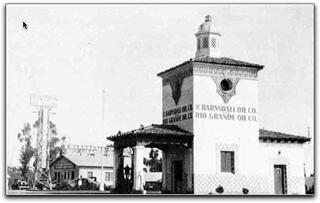
Ellwood School is an elementary school with kindergarten through 6th grade classes, plus a preschool. The building reflects the history of our area, notably the Barnsdall-Rio Grande Oil Company gas station built in 1929. Ellwood School emulates the historic building, with its white walls and striking blue and white tiles. Ellwood Union School, which is now Ellwood Elementary School, was built in the same year.
Ellwood Area History
intro written by Joan Barnett
Since I work at Ellwood School, just a stone’s throw down the road from this old gas station, the history of it is very interesting to me. I enjoy seeing the eyes of the Ellwood School children immediately light up when they see my photos of the station, saying enthusiastically, “I know where that is!”, and listen as I share more of what I’ve learned about the building. The photo to the left is one I took, showing what the station currently looks like. Our school, Ellwood Elementary School, emulates the design of the historic gas station, with the white walls and striking blue and white checkerboard tile design. I give full credit to a member of the oldgas.com/shoptalk forum, Curt Cragg, who summarized work of the authors of “Sentinel at Ellwood” and credit them for their excellent work. Unfortunately, the little book is now out of print.
———————————————————————————–
Part I: About the Barnsdall-Rio Grande Service Station building
The Barnsdall Rio Grande service station was built in 1929 and is one of the most architecturally significant service station in Californiaand perhaps the United States. Constructed in the popular Spanish colonial revival style of its time, it was designed by the same architectural firm that was responsible for many of the attractive Richfield service stations of the same time period.
One of the most notable features of the station was its tall tower. It covered only 450 square feet at the base but soared 40 feet into the air. The third floor of the tower held a 2,000 gallon water storage tank which provided pressurized water to the station. The station was situation at the entrance to the oil field owned by the Barnsdall-Rio Grande Oil Company and was intended to be a corporate showpiece. The first operator of the station was D.M. Tinsler. Under his management the station received a beautification award from the Garden Club of Santa Barbara and the Montecito Roadside Committee. The Montecito Roadside committee was particularly concerned about the unsightly accumulation of signage around service stations and along the roadways. The contest judges declared the grounds to be “finely kept” and relatively free from signs. In the years to come the station would receive many other awards for “excellent appearance”.
Today the station is located on a side road, but when it was originally built is was on the Coast Highway (now 101) and undoubtedly attracted the attention of the highway traveler. Even if the motorist was not in need of services they would be compelled to stop just to admire the architectural beauty of this unique station. If the service station didn’t stop them, the adjoining restaurant would.
Part II: History of Barnsdall-Rio Grande Service Station
Before we stop for lunch at the restaurant next to the station, a little history on the Barnsdall-Rio Grande Company and their discovery of oil on the shores of Ellwood Beach. There was no doubt that oil existed off of the shores of Santa Barbara. It had been discovered in Summerland just to the south in 1894 triggering a dramatic boom in population and speculation in this seaside Town. In fact, “Seaside” was on the the brand names adopted for the company behind this successful oil speculation.
It was Kate Den Bell, the daughter of Nicolas A. Den, a grantee of the Dos Pueblos Rancho, that predicted that oil would be found on the Ellwood shores in 1920. Kate would not allow her prediction to be explored during her lifetime, but after her death in 1928 a geologist named Frank Morgan convinced his employer, the Rio Grande Oil Co. to obtain exploration rights from Kate Bell’s heirs.
Seeking a partner for this wildcatting operation, the Rio Grande Company combined with the Barnsdall Oil Co. to explore this unproven location. They began drilling on June 1, 1928. They had agreed to drill to 3,000 feet at a cost of about $10.00 a foot and if the well didn’t prove out at that depth to give up. At 3,160 feet, the drilling supervisor asked for permission to pull the plug. As a last ditch effort before giving up they asked the geologist Morgan to have one last look at the final coring. Morgan detected traces of petroleum. They drove the bit ten more feet and struck a gas pocket, and at just over 3,200 feet they found the oil. It was a gusher generating 180 barrels per hour. The petroleum was so prolific that the company did not have the capacity to refine all of it as it was produced. While the storage and delivery facilities were being built Barnsdall and Rio Grande made arrangements with Seaside Oil Company to take all of the surplus flow.
The speculators behind the Barnsdall and Rio Grande Oil Companies were rich, paying $650,000.00 in taxes on their first year strike alone. Although the cost and design of the small flagship station seemed extravagant, the expense was nearly insignificant relative to the earnings of the rich oil reserve behind it along the shores of Ellwood in Santa Barbara County.
Wheeler Inn
Part III: The Wheeler’s Inn at the Barnsdall-Rio Grande Station
The Goleta station was the flagship of the operation but there were other less elaborate vessels flying the Rio Grande flag in Santa Barbara as well as at points north and south in Santa Barbara County. Like many stations along the coast highway, it made sense to add a diner to feed the travelers making their way up and down the coast of California. Initially the little eatery was called the “Spud Inn” as a play on the oilman’s term for starting a new oil well. Eventually, Laurence and Hilda Wheeler took over operation of the eatery and the name was changed to “Wheeler’s Inn”, a perfectly appropriate name for a restaurant attached to a service station.
Another significant change occurred during the depression in 1932 when Barnsdall-Rio Grande merged with the Sinclair Consolidated Oil Co.. Five years later, as the Depression set in, the conglomerate would become a principal stockholder of the previously bankrupt Richfield Oil Corporation. Despite these changes there was little change at the Barnsdall-Rio Grande station at Ellwood, still operating under the original colors with its original design intact.
Perhaps the most interesting event surrounding the Ellwood service station occurred in February of 1942 when a lone Japanese submarine lobbed a shell onto the shores of Ellwood beach, the only attack on American soil during World War II. This attack primarily had the effect of almost entirely eliminating the use of gas pump globes on the West Coast due to mandatory blackouts along shores of California. This elimination of what would later become a Petroliana commodity would frustrate western collectors for decades to come.
Although the Rio Grande Companies logo was rather bland, they had one of the most architecturally significant service stations ever created. Their early maps were also artistically beautiful featuring a rendering of the “Queen of the Missions”, the Santa Barbara Mission of California.
After World War II the highway was re-routed, as in many parts of California, and this historic station was left on a siding too far from the business that it needed to survived. The station ceased operation in 1950, but was used as a small bulk plant and card lock station after that until the early 70’s ending the run of the Rio Grande on the shores of Ellwood in Santa Barbara County.
-by Joan Barnett




